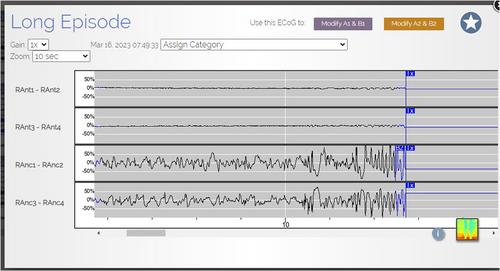Sudden unexpected death in epilepsy (SUDEP) is the most common cause of epilepsy-related mortality. Although most witnessed SUDEPs follow seizures, mechanisms are uncertain. Investigations into the pathophysiology of SUDEP have relied on models and rare recordings of brain function at the time of the event. The brain-responsive neurostimulation (RNS) device from Neuropace offers a therapeutic option for drug-refractory epilepsy (DRE), enabling the recording of brain activity and the preemptive termination of seizures. Therefore, patients who experience SUDEP while being treated with an RNS device can provide insights into neural activity at the moment of this event.
We report the history and electrocorticographic (ECoG) recordings of a patient with DRE who experienced SUDEP years after RNS placement.
A girl with Phelan–McDermid syndrome and Lennox–Gastaut syndrome had an RNS device implanted at the age of 14 to treat DRE. Initially, electrodes were positioned in the right orbitofrontal (OF) and right premotor frontal regions, with the OF lead later changed to the centromedian thalamic nucleus. At age 19, the patient was found unconscious and in cardiac arrest by her parents. Although spontaneous circulation returned en route to the hospital, the patient did not regain consciousness and died. Subsequent analysis of ECoGs from RNS recordings at the time of death indicated seizure onset in the right premotor frontal cortex, which persisted despite seizure termination attempts by the RNS.
We present a patient with SUDEP associated with the onset of RNS-refractory seizures. The significance of this report is highlighted by the rarity of literature on neuronal function at the time of SUDEP. Moreover, it underscores the potential for devices capable of monitoring ECoG activity to shed light on the mechanisms underlying SUDEP and to inform interventions.


